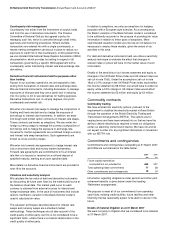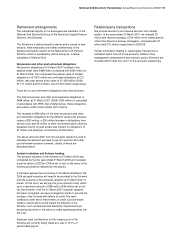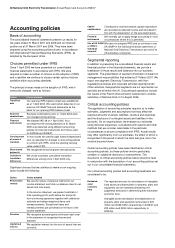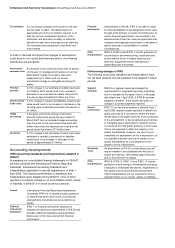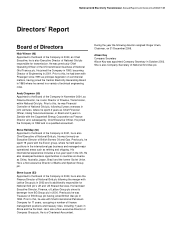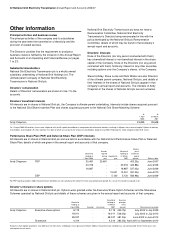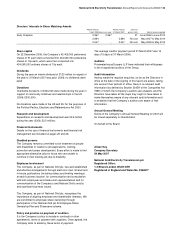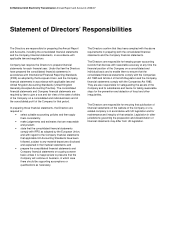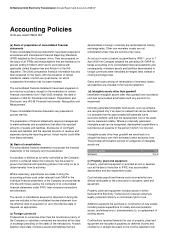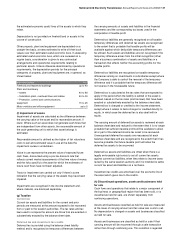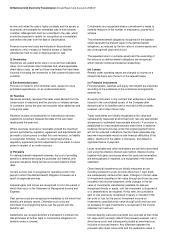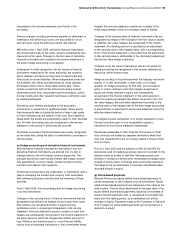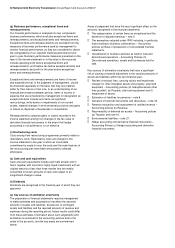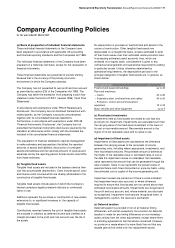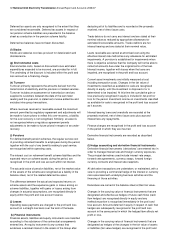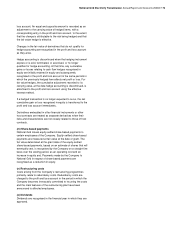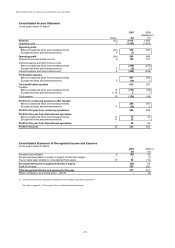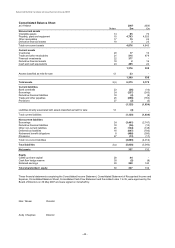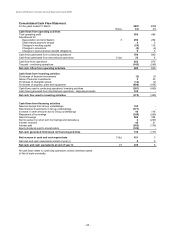National Grid 2007 Annual Report Download - page 38
Download and view the complete annual report
Please find page 38 of the 2007 National Grid annual report below. You can navigate through the pages in the report by either clicking on the pages listed below, or by using the keyword search tool below to find specific information within the annual report.
36 National Grid Electricity Transmission Annual Report and Accounts 2006/07
Accounting Policies
for the year ended 31 March 2007
(a) Basis of preparation of consolidated financial
statements
These consolidated financial statements have been prepared in
accordance with International Financial Reporting Standards
(IFRS) adopted by the European Union. They are prepared on
the basis of all IFRSs and Interpretations that are mandatory for
periods ending 31 March 2007 and in accordance with
applicable United Kingdom law and Article 4 of the IAS
regulation. The 2006 comparative financial information has also
been prepared on this basis, with the exception of certain
standards, details of which are given below, for which
comparative information has not been restated.
The consolidated financial statements have been prepared on
an historical cost basis, except for the revaluation of certain
financial instruments from 1 April 2005 onwards, the date of
adoption of IAS 32 ‘Financial Instruments: Presentation and
Disclosure’ and IAS 39 ‘Financial Instruments: Recognition and
Measurement’.
These consolidated financial statements are presented in
pounds sterling.
The preparation of financial statements requires management
to make estimates and assumptions that affect the reported
amounts of assets and liabilities, disclosures of contingent
assets and liabilities and the reported amounts of revenue and
expenses during the reporting period. Actual results could differ
from these estimates.
(b) Basis of consolidation
The consolidated financial statements incorporate the financial
statements of the Company and its subsidiaries.
A subsidiary is defined as an entity controlled by the Company.
Control is achieved where the Company has the power to
govern the financial and operating policies of an entity so as to
obtain benefits from its activities.
Where necessary, adjustments are made to bring the
accounting policies used under relevant local GAAP in the
individual financial statements of the Company and subsidiaries
into line with those used by the Company in its consolidated
financial statements under IFRS. Inter-company transactions
are eliminated.
The results of subsidiaries acquired or disposed of during the
year are included in the consolidated income statement from
the effective date of acquisition or up to the effective date of
disposal, as appropriate.
(c) Foreign currencies
Transactions in currencies other than the functional currency of
the Company or subsidiary concerned are recorded at the rates
of exchange prevailing on the dates of the transactions. At each
balance sheet date, monetary assets and liabilities that are
denominated in foreign currencies are retranslated at closing
exchange rates. Other non-monetary assets are not
retranslated unless they are carried at fair value.
As set out in note (o) below, as permitted by IFRS 1, prior to 1
April 2005 the Company adopted the prevailing UK GAAP for
hedge accounting in its consolidated financial statements and,
consequently, monetary assets and liabilities denominated in
foreign currencies were translated at hedged rates instead of
closing exchange rates.
Gains and losses arising on retranslation of monetary assets
and liabilities are included in the income statement.
(d) Intangible assets other than goodwill
Identifiable intangible assets other than goodwill are recorded at
cost less accumulated amortisation and any provision for
impairment.
Internally generated intangible fixed assets, such as software,
are recognised only if an asset is created that can be identified;
it is probable that the asset created will generate future
economic benefits; and that the development cost of the asset
can be measured reliably. Where no internally generated
intangible asset can be recognised, development expenditure is
recorded as an expense in the period in which it is incurred.
Intangible assets other than goodwill are amortised on a
straight-line basis over their estimated useful economic lives.
The principal amortisation periods for categories of intangible
assets are:
Amortisation periods Years
Software
3 to 5
(e) Property, plant and equipment
Property, plant and equipment is recorded at cost or deemed
cost at the date of transition to IFRS, less accumulated
depreciation and any impairment losses.
Cost includes payroll and finance costs incurred which are
directly attributable to the construction of property, plant and
equipment.
Property, plant and equipment includes assets in which
National Grid Electricity Transmission’s interest comprises
legally protected statutory or contractual rights of use.
Additions represent the purchase or construction of new assets,
including capital expenditure for safety and environmental
assets, and extensions to, enhancements to, or replacement of
existing assets.
Contributions received towards the cost of property, plant and
equipment are included in payables as deferred income and
credited on a straight-line basis to the income statement over


